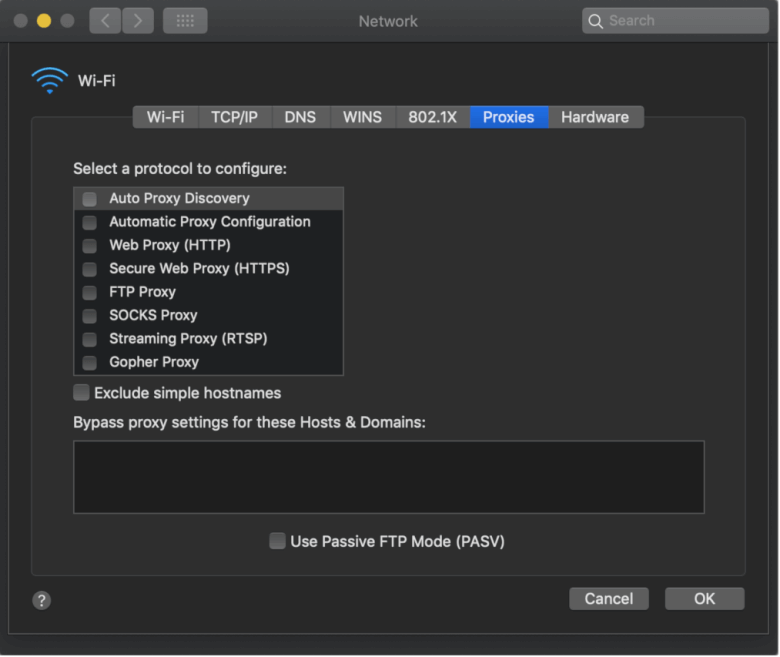

You can use any of the following variables for the password value: $PASSWORD$, $USER_CUSTOM1$, $USER_CUSTOM2$, $USER_CUSTOM3$, $USER_CUSTOM4$. Enter the password for authenticating with the proxy server. Custom attribute variable substitutions are supported. You can also combine text with variables, such as $USERID$:$USER_CUSTOM1$ or $USERID$_$USER_CUSTOM1$. You can use any of the following variables for the username value: $USERID$, $EMAIL$, $USER_CUSTOM1$, $USER_CUSTOM2$, $USER_CUSTOM3$, $USER_CUSTOM4$. Enter the user name for authenticating with the proxy server. If you do not enter values for the proxy server username and password, supervised device users will need to enter a username and password every time they access the proxy server.Įnter the network address for the proxy server.Įnter the port number for the proxy server.
#Macproxy configuration registration
If you do enter a value for the password, go to Settings > System Settings > Users & Devices > Registration > Save User Password Preferences and select Save User Password. Optionally, enter values for the username and password used for devices to authenticate with the proxy server. If you select Manual, specify the proxy server address and port through which all HTTP traffic will be directed. Because this priority applies only to custom policies, this field is not enabled when you create the first custom policy of a given type.Įnter an explanation of the purpose of this policy. For example, to give Policy A a higher priority than Policy B, you would select “Higher than” and “Policy B”. Select Higher than or Lower than, then select an existing policy from the drop-down list. This priority determines which policy is applied if more than one policy is associated with a specific device. Specifies the priority of this custom policy relative to the other custom policies of the same type.

The policy definition is preserved in case you want to turn it on again. Why: Use the Status feature to turn a policy on or off across all phones affected by it. Tip: Though using the same name for different policy types is allowed (e.g., Executive), consider keeping the names unique to ensure clearer log entries. This name must be unique within this policy type. This is the text that will be displayed to identify this policy throughout the Admin Portal. Enter a descriptive name for this policy. Apply the policy to the appropriate labels.īelow are the setting definitions for the New Global HTTP Proxy Policy dialog box.In the New Global HTTP Proxy Policy dialog box, use the guidelines in Global HTTP Proxy Policy to complete this form.Select Add New > iOS and macOS > iOS Only > Global HTTP Proxy.In this case, physical access is required to reset the device. An invalid or unreachable proxy server will make the device unreachable by the network. The direct connection and proxy bypass options apply only to supervised iOS 7 through iOS 9.3 devices.Ĭonfirm that you have specified the correct proxy information, and the proxy is reachable. they must first log in to a captive portal before accessing a wifi hotspot.The PAC file referenced in their global HTTP proxy policy is unavailable The direct connection and proxy bypass features allow supervised iOS 7 through iOS 9.3 devices to continue accessing the internet even if:

If your organization uses a proxy server to provide data leak protection or content filtering, for example, a global HTTP proxy policy allows you to direct HTTP traffic to and from supervised iOS 6 through iOS 9.3 devices to the proxy server of your choice. Device users establish uninterrupted wifi internet access by logging in through the captive portal before the policy redirects them to the proxy server. Selecting this option allows the device to connect directly to the captive network. Proxy bypass: You can configure the policy to bypass the proxy server altogether when a device attempts a connection to a captive network such as a wifi hotspot at a coffee shop or a hotel.This option applies only to automatic proxy connections. Direct connection: For circumstances where the PAC file is unreachable, you can specify that the policy create a direct connection to the requested URL, bypassing the proxy server altogether.The global HTTP proxy policy can include two features that provide solutions on-the-fly for when devices cannot access the proxy server: If the policy does not include a URL to the PAC file, then the policy uses WPAD (web proxy auto-discovery) to attempt to locate the PAC file. You can manually enter the proxy server URL and port number, or the URL for the relevant PAC (proxy auto-configuration) file, which automatically determines the correct proxy server to use for a given URL. By imposing a global HTTP proxy policy on supervised iOS 6 through iOS 9.3 devices, you can ensure that HTTP traffic is redirected to the proxy server you specify.


 0 kommentar(er)
0 kommentar(er)
